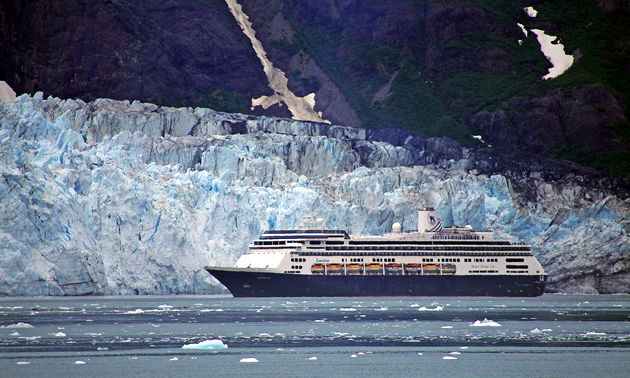Exploring the Alaska Panhandle and Peninsula
From Ketchikan to Katmai National Park and beyond

The Alaska Panhandle, Kenai Peninsula and Alaska Peninsula encapsulate extensive wilderness area of forests and mountain ranges—that beguile and excite the minds of tourists across North America and the world.
The area is home to animals and features of Mother Nature that cannot be found anywhere else on Earth. Alaska is the last frontier before Arctic wilderness in the North, and if RVers have a chance to experience it, they should jump at the opportunity.
To help travellers discover the wonders of the southern edge of Alaska, here is a collection of popular locations and activities from East to West that can be used as a starting line for the ultimate road trip.
The Alaska panhandle
Ketchikan is a small city on Revillagigedo Island within the Tongass National Forest. Aboriginal heritage and culture are on display at the local Totem Heritage Center, which houses 33 totems retrieved from deserted Tlingit and Haida villages. Beginning in Ketchikan, continuing up the panhandle and down the peninsula are totemic arts in galleries, forests and museums.
Stopping in Wrangell to see the native petroglyphs of Petroglyph Beach State Historic Park (ancient symbols carved into the boulders along the shore) is easy when travelling by ferry.
The fishing port of Petersburg embraces its Scandinavian and Viking roots by encouraging the nickname “Little Norway.” The city even celebrates Norwegian Independence Day every May 17. The Clausen Memorial Museum, the Marine Mammal Centre, the Petersburg Lake walking trail and other excursions are worth checking out before leaving Petersburg.
Glacier Gardens, Glacier Bay National Park and the Juneau Ice Field (including the Mendenhall Glacier) should put Juneau at the top of every traveller’s list. The national park is the best place in the area to find humpback whales. Visitors can take a ferry or fly from Juneau to the other surrounding islands. For a unique eating experience after viewing the majesty of glaciers, ice fields and whales, you can check out the Red Dog Saloon or Alaska Fish and Chips Co. across from Juneau Harbour.
Tlingit, Russian and American settlers have always called the city of Sitka home. The Sitka Sound Science Center, the Fortress of The Bear and the Alaska Raptor Center are opportunities to see local wildlife on display. Boat and car tours, whale-watching, biking races, kayak rentals, hiking, golfing and flightseeing are ways tourists can see the area. Historic sites like the Russian Bishop’s house, built in 1842, and the Tlingit Art Museum are great ways to experience the area’s culture on a deeper level.
Hikers around the city of Skagway can find old pickaxes, wagon wheels, shovels and countless other items from gold miners who came this far and turned around when they found nothing.
The 19,425-hectare (48,000-acre) Chilkat Bald Eagle Preserve is accessible by vehicles on Highway 7, via the Alaska Marine Highway System's ferry, and by cruise ship. The preserve is the ideal place to see America’s totem animal in action. The birds have made it a habit to stay close to the area, as many species of fish migrate to the area for breeding (and become easy targets for grabbing talons).
The in-between
Some of Alaska’s best glaciers can be found in Prince William Sound, accessed via Whittier, Valdez or Cordova (or from the east side of Kenai Peninsula). Private boat excursions depart daily from these communities and allow visitors up-close and personal experiences with the beautiful walls of ice—the Worthington Glacier near Valdez being one of the most notable.
Denali National Park is the one of the largest in the U.S. and is home to North America's highest mountain. Denali is the 6914-metre (20,320-foot) mountain’s traditional name, but mountaineers and local explorers have dubbed it Mount McKinley.
Anchorage’s Alaska Air Museum and Anchorage Museum put the city on the map. The city’s bike paths, all 217 kilometres (135 miles) of them, can be traversed by rented bike or personal one. The Tony Knowles Coastal Trail allows riders to get right down to the shore at parts of its 17 kilometers (11 miles). The Anchorage Railway (how the city got its start) has tours and trips running each day during the summer to Seward, Prince William Sound, Denali, Talkeetna and Fairbanks. Panning for gold, riding a dogsled, consuming fresh seafood and taking in the northern lights are also trip highlights that can be enjoyed in Anchorage.
The Peninsula
Leaving Anchorage to the west will take visitors to the Alyeska Aerial Tram. It’s a great way to see seven hanging glaciers year-round, and moose and bears during the summer. Portage Glacier is found a little farther towards the south. Driving the Whittier Tunnel is also a popular activity in the area and leads to the must-experience town of Whittier.
Kenai Peninsula Borough and Kenai Fjords National Park can be accessed via Anchorage and the Seward Highway. The Alaska Wildlife Conservation Center is along the highway heading into the peninsula, making it a convenient spot to become familiar with the area’s creatures.
Alaska SeaLife Center is in Seward and is home to puffins, sea lions, octopi and more. The centre offers encounters for those who want to book their visits ahead of time. The scientists who run the centre focus on species preservation and general public education.
Since 1918, Katmai National Park and Preserve has protected 9,000 years of history, important habitats for salmon and vast areas of forest land for thousands of brown bears (whose population is in the thousands). The park is also home to Brooks Camp where one can find the perfect jumping-off point for other world-class outdoor adventures like hiking, fishing and flightseeing. The unique appeal of the camp is that visitors can traverse a large bridge and platform to view brown bears in their natural habitat. Daily bus tours leave from the camp and take travellers out to the site of the largest volcanic eruption of the 20th century—Valley of Ten Thousand Smokes.
Nanek Lake, within the Katmai National Park boundary, offers campers some close encounters with bears, as well as great fishing opportunities. An interesting aspect of the lake is the volcanic pumice stones on the beach. Throwing these rocks into the water will resulting in floating rocks.
Kodiak Island Borough has many hiking trails, parks, historical buildings, aquariums and its own brewing company. The Kodiak Military Museum is located in a Second World War bunker and hosts many artifacts and documents that history buffs must see. The Kodiak Brewing Company was established in 2003 and has since been serving hand-crafted beer (liquid sunshine) with an island flair. Fort Abercrombie State Historical Park preserves natural history, walking trails and puffin nesting grounds (the ideal location to spot puffins sans wildlife enclosures). Fossil Beach has boulders on its waterfront that have fossilized shells and fish skeletons that are easy to see and display tiny bits of Alaska’s past.
For more information about the wonders of Alaska, visit the Tourism Alaska website.






